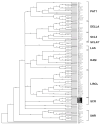Conservation and diversification of SCARECROW in maize
- PMID: 16244911
- PMCID: PMC1475827
- DOI: 10.1007/s11103-005-0578-y
Conservation and diversification of SCARECROW in maize
Abstract
The SCARECROW (SCR) gene in Arabidopsis is required for asymmetric cell divisions responsible for ground tissue formation in the root and shoot. Previously, we reported that Zea mays SCARECROW (ZmSCR) is the likely maize ortholog of SCR. Here we describe conserved and divergent aspects of ZmSCR. Its ability to complement the Arabidopsis scr mutant phenotype suggests conservation of function, yet its expression pattern during embryogenesis and in the shoot system indicates divergence. ZmSCR expression was detected early during embryogenesis and localized to the endodermal lineage in the root, showing a gradual regionalization of expression. Expression of ZmSCR appeared to be analogous to that of SCR during leaf formation. However, its absence from the maize shoot meristem and its early expression pattern during embryogenesis suggest a diversification of ZmSCR in the patterning processes in maize. To further investigate the evolutionary relationship of SCR and ZmSCR, we performed a phylogenetic analysis using Arabidopsis, rice and maize SCARECROW-LIKE genes (SCLs). We found SCL23 to be the most closely related to SCR in both eudicots and monocots, suggesting that a gene duplication resulting in SCR and SCL23 predates the divergence of dicots and monocots.
Figures




References
-
- Altschul SF, Gish W, Miller W, Myers EW, Lipman DJ. Basic local alignment search tool. J Mol Biol. 1990;215:403–410. - PubMed
-
- Arabidopsis Genome Initiative. Analysis of the genome sequence of the flowering plant Arabidopsis thaliana. Nature. 2000;408:796–815. - PubMed
-
- Benfey PN, Linstead PJ, Roberts K, Schiefelbein JW, Hauser MT, Aeschbacher RA. Root development in Arabidopsis: four mutants with dramatically altered root morphogenesis. Development. 1993;119:57–70. - PubMed
-
- Birnbaum K, Shasha DE, Wang JY, Jung JW, Lambert GM, Galbraith DW, Benfey PN. A gene expression map of the Arabidopsis root. Science. 2003;302:1956–1960. - PubMed
Publication types
MeSH terms
Substances
Grants and funding
LinkOut - more resources
Full Text Sources
Other Literature Sources

